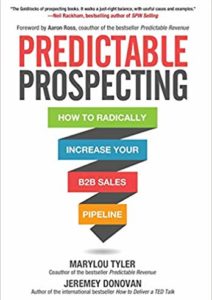Recently I was interviewing Tim, a busy business development rep, as part of my assessment for a new client. Tim confided in me that his first calls were not going as well as he had hoped.
Although he had names and titles of people to call, and did his research, he was not able to confidently state why he was calling, how to get people interested in what he was calling about, or navigate to the proper person if his initial contact wasn’t the right person.
After listening to Tim and the rest of the team, I instantly rallied a training session that inevitably made the entire team three times more productive after one week of dedicated practice.
What do you think? Do you feel good about your first calls?
I’m going to share with you what I taught in that impromptu session so you can immediately drive growth for your business.
Step 1: Prepare for call success
Think you can get a key prospect on the phone and just wing it? You’re only fooling yourself. The instant that prospect senses on-the-fly, they’ll automatically assume you’re a salesperson and you’re dead in the water. Therefore, you must prepare.
Put on your detective hat and dig up answers to these three questions:
- Why should your buyer change how he does things?
- Why change now?
- Why choose you?
Know How You Help
Learn how your organization helps clients and translate what you’ve learned into value-added benefits. What results do clients get after they choose you? It’s vital you explain your value.
Here’s a simple exercise to complete in about 15-20 minutes:
For each product or service, fill in 2 columns of the table:
-
Describe your product or service (or break down by feature if that’s relevant).
-
List 5 problems that your product solves.
Review your table(s) once daily. Write them out in long hand. More than once. Continue to absorb until it feels natural. How do you know you’ve absorbed the material? If I came to your house at 3AM, woke you up from a dead sleep and asked you what your product does for me, your response, although somewhat sleep deprived, should be thought provoking and instantaneous.
Bonus exercise: If you sell to multiple buyers, create a table for each buyer type.
Anticipate Objections
Let’s be honest. You’re going to hear objections. Perhaps a multitude of them. But if you prepare common objections with logical rebuttals, you’ve built a toolbox full of ways to overcome them.
Using the chart below, take another 15-20 minutes to complete:
1. Create scripts of common objections,
2. List how you resolve them with benefits, and then…
Role Play and Record
It’s time to come together and leverage the power of your team:
1. Build buyer’s language scripts filled with common objections, dialog and questions.
2. Cover the types of first calls you expect to have.
3. Find-the-right-person
- Gatekeeper
- Got-the-right-guy – ask are-we-a-fit, discovery or relevant next sales step questions
- Reception / front-desk.
- Role play calls
4. Switch roles – you as you, then you as the prospect.
5. Record role play calls and review with the team. Discuss and critique. Critique the good as well as the not-so-good.
When the troops are ready to get back to it, record live calls as well. Play both good and rough calls to the team. This helps reps spot their own strengths and weaknesses to improve. Keep recorded calls for training purposes. It shortens the onboarding process of new reps.
Step 2. Prospect
It’s time to put the rubber to the road and pick up the phone and dial. Using the scripts you’ve prepared in the above 2 exercises, keep these concepts in mind:
- Treat the call as a warm call, not a cold call
- You’ve done your research & perhaps sent relevant material to the prospect already. You are connecting with someone who may benefit from your conversation.
- Keep a light, casual tone. Similar to how you speak with a personal friend. Smile. People can actually hear you smile. This helps with your comfort level.
- And remember, many times the first call is used to confirm they are the right person to talk to or ask for a suggested referral in case they are not the right person. Nothing to be tense about.
Gatekeepers are our friends
A lot of “gurus” will teach you to be stern with the gatekeeper, command authority, and scare them out of their wits. Inferring you’re important. This may work once with the gatekeeper, but after they catch an earload from their boss, it will never happen again.
Besides, gatekeepers are real people. Treat them as you want to be treated. Win their trust by being authentic & genuine. Ask their advice on how they think you should proceed. Make them feel valued. They will work with you, not against you, if you treat them with respect.
Less specificity, more puzzle piecing
Imagine you’re a savvy, curious detective working on a hot case. Ask questions to piece together the puzzle of mapping the organization, uncovering who you should be talking to. Be curious. When you get stuck, check out this guide from Allego for advice.
Lastly, have your clear benefit pitch (why change, why now, why you) ready and waiting in the hopper. Just in case you’re connected to the decision maker on that first call. It does happen at times, so always be ready.
Step 3: Post
No matter if your calls are good or bad, if you’ve learned something new on your call, record it in the CRM. I like to have clients record meaningful conversations and disposition calls with specific codes that help us better understand the nuances of the pipeline.
Having impeccable, up-to-date prospect information in your CRM is the key to building a predictable and consistent pipeline.
Bonus Insights: What you learn in your conversations (buyer language, objections, likes, dislikes) can be used as repurposed material for your e-mail messages, nurture content and even phone scripts to build tighter bonds and faster rapport between you and future buyers.
Your Results Will Blow You Away
I’ve seen teams post success rates from a low of 2 – 5% to a high of 87% following the above process. That is, for every 10 people they talk to, 8.7 of those people either:
-
point them in the right direction,
-
confirm they are the right person, or
-
engage in some level of discovery
Why? Because what they heard sounded interesting, was relevant, piqued their curiosity, or they understood enough to route the call appropriately.
Have a question, comment or amazing story in boosting your success rate that you’d like to share with our community? Leave one below.













